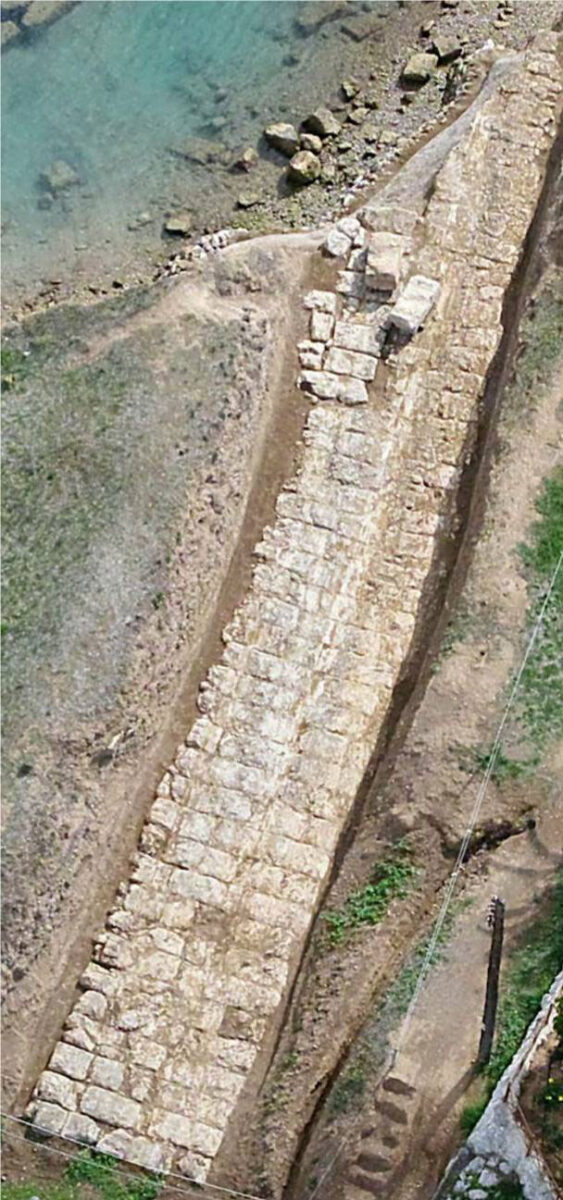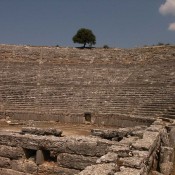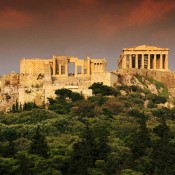The Central Archaeological Council unanimously approved the studies for the restoration of the Ancient Diolkos, one of the most important technical works of antiquity. The proposal to restore the ancient cobbled road on which ships were transported from the Corinthian to the Saronic Gulf treats the monument as a single structure and not as a number of intermittent sections. It also envisages the configuration of the surrounding area of the monument, in order to become a modern and organized archaeological site.
Minister of Culture and Sports Lina Mendoni said: “The Ancient Diolkos, one of the most important engineering works of the ancient Greeks, united two key ports of antiquity, Kechries and Lechaion in the Saronic and Corinthian Gulf respectively, to avoid the long and dangerous voyage of circumnavigating the Peloponnese. It is a technological marvel of the Pre-Classical period and the first systematic attempt to transport goods and warships from the Saronic to the Corinthian Gulf, and vice versa. Approaching the monument holistically, the proposed interventions aim to address any damages on the monument, to organize and shape the greater archaeological site and highlight the monument as a whole. The project, being prepared by the competent services of the Ministry of Culture in collaboration with the Region of the Peloponnese, is evolving in parallel with the technical and security works being conducted in the Canal. These two very important technical works of antiquity and the 19th century, each with its own physiognomy, will give impetus to the development of the region of Corinth”.
The study is a continuation of the approved preliminary one for the protection, restoration and enhancement of the Ancient Diolkos and includes its archaeological documentation, an architectural and geotechnical study and a chemical analysis of the natural stones. As part of the study, work will be conducted on backfilling, retrieving and conserving the sunken stone blocks and putting them back in place. Aesthetic upgrading and protection related interventions have been foreseen in the parts of the monument on land, as well as stabilizing, conservation and restoration. The study, included in the Regional Operational Programme “Peloponnese 2014-2020” of the NSRF, is being overseen by the Ephorate of Antiquities of Corinth. The project is part of a wider framework of interventions in the area for the protection of the Ancient Diolkos with the Regional Unit of Corinthia acting as implementing body.
The configuration of the monument’s surrounding area includes the creation of a protection zone, a tour route for visitors between the monument and the breakwater, the configuration and levelling of the slopes. People with disabilities will be able to access the site and seats, sign posts and information material in Braille will be provided. The proximity of the monument to the Corinth Canal has caused serious problems for the Diolkos. Corrosions caused by the underwater currents, intensified by the passage of ships, has led to the collapse of part of the monument and a significant loss of its original components.
The Ancient Diolkos was probably built in the 6th century BC during the rule of Periandros, tyrant of Corinth. The first reference to the Diolkos was made in 1883 by German archaeologist Habbo Gerhard Lolling, who identified visible remains of the monument at the western end of the Canal then under construction. The total length of the Diolkos from coast to coast was about 8 km. Today its known course is about 1 km. The ships were towed along a 3.5-4 meters wide cobbled road. Systematic excavations of the monument were conducted by N. Verdelis between 1957 and 1959. These works uncovered the route of the Diolkos in the area of Poseidonia, its extreme western section. Parts of it are visible at the western end of today’s Canal on both the side of the Peloponnese and Continental Greece. The route on the eastern part has not yet been found, nor its end facing the Saronic Gulf, which is located in the area of ancient Schinoundas (today’s Kalamaki).





